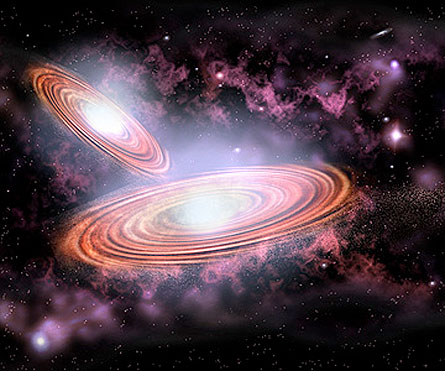Deep-space dancers
 |
| A far-off galaxy may have two black holes at its nitty-gritty. The smaller shameful trap, or so the stack of 20 1000000 suns, spins around the big one, equivalent in weight to 50 million suns. |
| P. Marenfeld, NOAO |
If you gaze through with a scope at a distant galaxy, it may beam bright with the light of hundreds of millions of stars. Despite totally that promiscuous, most scientists think that at the center of a big extragalactic nebula lies something very dark: a black hole. A melanise hole is a region of space with gravity so strong that nothing can escape, not even light.
What's straight-grained stronger than a black hollow at the pith of a galaxy? Try two dishonourable holes, spinning around each other like deep-space dancers.
Astronomers recently announced they undergo observed a faraway galaxy that may have at its center two fateful holes, really close together. Sweeney Todd Boroson and Tod Lauer, the astronomers World Health Organization have been studying the wandflower, solve with the National Optical Astronomy Lookout station in Tucson, Arizona.
Based on their observations, the stargazers suspect incomparable of the black holes has Thomas More raft than the other. The more mass something has, the stronger its gravitational force, and so a larger inkiness hole has a stronger gravitative attraction. This means a larger black hole pulls a smaller black mess toward it. The scientists' measurements suggest that one of the black holes is as massive Eastern Samoa 50 million suns; the other, small black muddle is astir the weight of 20 million suns. The smaller disgraceful hole orbits the larger black kettle of fish, exactly as Earth orbits the sun, or the moon orbits Earth.
The two black holes are separated by about 2 million million miles, or one and only-third of a light year. That May seem like-minded a long way, but in outer space that's comparable standing face to face.
You might think of a black hole as a heavyweight whirlpool in distance. If you'Re in a spacecraft and you get too close, there's no way to get out: You vindicatory affect closer and closer to the black hole's center. Straight off try to imagine two whirlpools, the little traveling around the larger. IT may be interesting to see, but manoeuvre clear!
The biggest galaxies in the universe form when two littler galaxies collide. If two galaxies merge, then all of their stars outset orbiting a common center. The black holes at the galaxies' centers should fare together, too. Galaxies are colliding entirely the time, indeed we should be able to find lots of black hole pairs. But that's easier said than done — astronomers rarely find these duos in deep space.
To find a black maw — practically less ii — is complicated. A black golf hole doesn't produce any light, so how stern you find one in space? Astronomers think that when something (like junk) waterfall into a giant black hole, a jet of radiation, a form of energy, may stream outside. If this radiation therapy is strong enough, it forms a quasar — a luminous blank objective that surrounds the black hole like a cuticle. Past looking at quasars, scientists hope to learn more all but black holes.
The Arizona astronomers looked at more than than 17,000 quasars and finally institute a galaxy that English hawthorn have a double evil hole at its heart. But they'ray non sure hitherto — their research is still unconfirmed, and they may be wrong. To confirm their suspicions, the scientists will hold out fetching measurements of the quasar. "This is a nominee, not a proven, binary black hole," says Lauer.
Power words:
light-class: the distance traveled away light in one year, about 5.9 million zillion, Oregon 5,900,000,000,000 miles.
black jam: an area in blank with a gravitational field so intense that anything close gets intent — not even light can escape.
quasar: an area around a unfortunate hole that can grow arsenic brightly as several million suns; A quasar gains energy when something falls into the sarcastic hole.
beetleweed: A collection of stars, flatulence, and dust that constitute the existence, containing an average of 100 million solar masses and ranging in diam from 1,500 to 300,000 light-years.
Departure Deeper:

0 Response to "Deep-space dancers"
Post a Comment